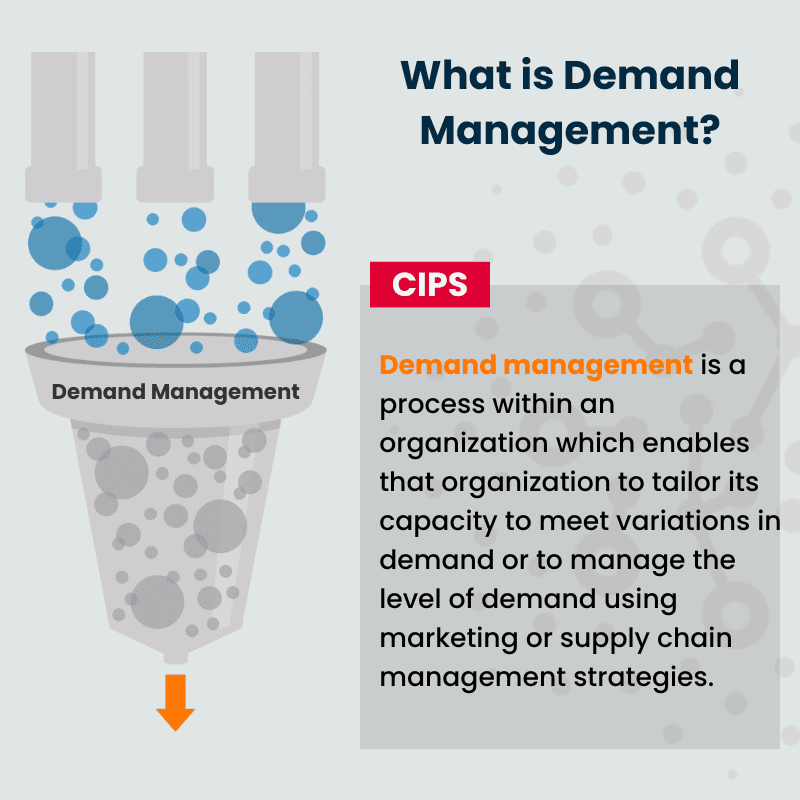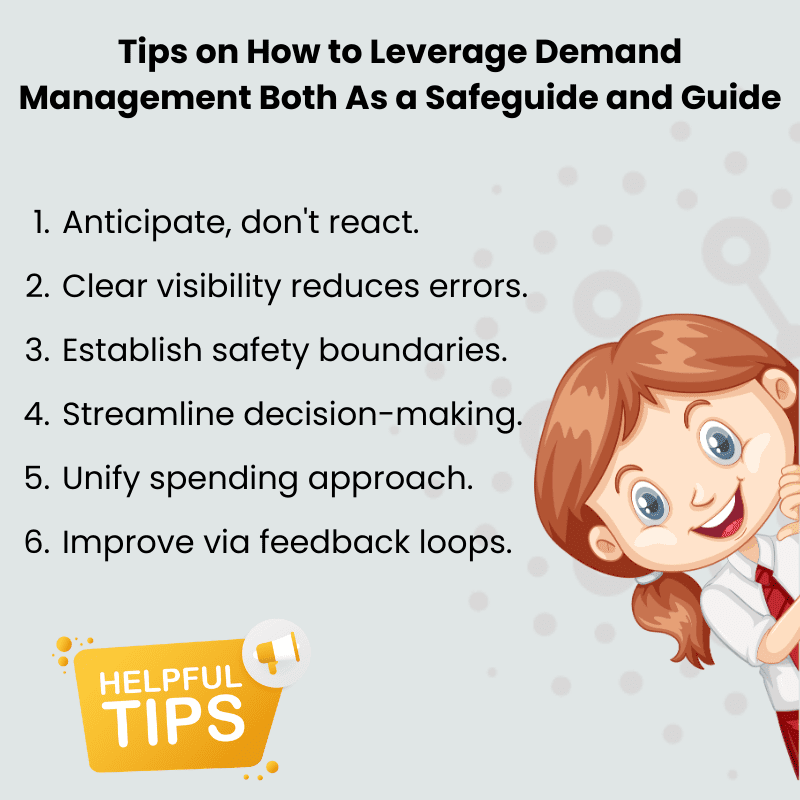In the dynamic landscape of modern business, companies often find themselves in a delicate balancing act, particularly when it comes to demand management for consulting services. Juggling demands in terms of resources, time, and capital becomes a crucial exercise. Within this complex environment, financial expenditures, especially in fields like consulting, stand out.
Consulting, with its ever-evolving nature, challenges even the most adept managers. But this is where demand management for consulting services steps in. It’s not just about reining in costs or maintaining control. It’s about unlocking real value from every decision.
Demand management for consulting services serves as both a guide and a safeguard, ensuring businesses extract maximum value while staying on the right path. So, for those aiming to master this intricate dance of managing demands, especially in consulting, let’s delve deeper.

1. The Power of Anticipation Over Reaction
In the bustling corridors of corporate operations, the balance between anticipation and reaction often tilts towards the latter. Traditionally, many organizations operate reactively—spending until a budget threshold is breached and then, almost in a state of panic, making hurried adjustments. This approach is akin to driving a car by only looking in the rear-view mirror; you’ll always be one step behind, reacting to situations after they have already occurred.
Effective demand management for consulting services offers a visionary approach, much like looking through the windshield while driving, allowing one to see and navigate challenges well in advance. By forecasting and managing demands proactively, companies not only steer clear of the pitfalls of overspending and misallocation but also position themselves to seize potential opportunities.
Illustrative of this reactive approach is a conversation I once had with a Chief Procurement Officer (CPO) of a prominent firm. When posed with what seemed like a straightforward question, “How much do you spend on consulting?”, there was a noticeable pause.
The CPO confessed that he didn’t have an immediate answer and would need about 20 minutes to find out. As we resumed our conversation after the stipulated time, he came back with a figure. While it was a relief that this number lay well below the industry average of 0.5 to 1.5% of the revenues, it was alarming to consider the alternate scenario.
What if the number had been excessively high? The crux of this anecdote is the unsettling realization that even at leadership levels, there might be a blind spot when it comes to real-time knowledge of organizational spendings.
This tale serves as a reminder of the importance of anticipation in business operations. Without a robust demand management system, even the most seasoned professionals can be caught off-guard, unaware of the financial undertows pulling their organization in undesired directions.
In the dynamic world of business, knowledge isn’t just power; it’s foresight. And in the realm of financial management, foresight can make all the difference between proactive strategy and reactive damage control.
2. Clearer Visibility Equals Fewer Errors
Understanding where resources are allocated and how effectively they are utilized is crucial in business. This idea harkens back to the timeless wisdom of management guru Peter Drucker: “What gets measured, gets managed.” Beyond just managing, however, there’s a deeper truth — you also can’t effectively control what you can’t measure.
Demand management tools and strategies have surged to the forefront of business strategy because they provide the clarity and oversight organizations desperately need. They unveil a panoramic view into spending, allowing leaders to dissect and analyze every expense, every allocation. This level of transparency is transformative. It’s like turning on a high-powered spotlight in a previously dim room.
With this newfound clarity, leaders are empowered in two distinct ways:
Minimizing Mistakes: A comprehensive view of financial outflows means that areas of excessive spending stand out starkly. Similarly, underutilized resources, which could be bleeding the company’s finances, become apparent. Such a level of detail means that misallocations or errors are caught swiftly, saving the company potentially significant amounts over time.
Informed Decision-making: With a bird’s-eye view of company spendings, leaders aren’t just reacting to issues; they’re anticipating them. They can strategize about where to allocate resources next, which departments need more investment, and which ones need a restructuring of sorts. This proactive approach is only possible with the right data in hand.
And there’s an added layer of strategic control. When you’re consistently measuring, you’re not only spotting current trends but also predicting future ones. This foresight enables businesses to be agile, adjusting their sails before the storm hits, rather than being caught unaware.
In essence, the measure-to-manage principle is not just about avoiding pitfalls; it’s about leveraging insights for strategic advantage. In a world where the margin between success and failure is razor-thin, such control becomes an invaluable asset for any organization.
3. Setting Boundaries: The Safety Nets
In the competitive world of business, every decision counts, and every investment has repercussions. When it comes to consulting, the stakes are even higher. This isn’t just about getting a service; it’s about securing a competitive edge, finding a solution to pressing challenges, and propelling the business forward.
In this light, consulting is not just another line item in the budget; it’s a pivotal strategic investment that can impact everything from the top line and bottom line to EBITDA and even the overall valuation of a company. The question then becomes: How do you ensure you’re getting optimal value from such a vital investment?
This is where the principle of guided investment, anchored in effective demand management for consulting services, takes center stage. It’s not about curbing or suppressing expenditure, but about channeling it in the most purposeful direction.
Setting clear boundaries and guidelines is paramount. Think of it as plotting a strategic map; these guidelines act as the signposts ensuring the journey remains on course. They are the buffers that prevent an organization from deviating into the terrain of inefficiencies and misallocations.
Such boundaries serve dual purposes:
Aligning Expenditure with Vision: By setting clear parameters, organizations ensure that every investment in consulting maps back to the larger strategic objectives. This means that every project, every consultation, is a step towards realizing the overarching business vision.
Safeguarding Against Missteps: These guidelines act as safety nets. Just as a trapeze artist relies on a net below, businesses can take calculated risks, innovate, and push boundaries, knowing there’s a structure in place to catch them if things don’t go as planned.
To underscore its importance, managing consulting as an investment is akin to a chess grandmaster contemplating each move’s repercussions several steps ahead. It’s strategic, thoughtful, and crucially, always in pursuit of a long-term checkmate. Investing in consulting should be approached with the same gravitas and foresight, recognizing its potential to be a game-changer in the business landscape.

4. Streamlined Decision-Making Processes
Consulting can be a strategic linchpin for many organizations, offering a unique blend of external expertise and problem-solving prowess. However, without a clear and streamlined decision-making process, it’s all too easy for this powerful tool to become a crutch, particularly in the face of resource constraints or hiring freezes. There lies the risk: over-dependence on consulting, which might not only be financially burdensome but can also create a culture of reliance rather than self-sufficiency.
Effective demand management for consulting services introduces a delicate balance, shaping the way decisions around consulting expenditure are made. When every proposed expenditure is held against predefined criteria, it removes whimsical or reactive spending, ensuring each consulting engagement is deliberate and value-driven.
Two distinct advantages emerge from this approach:
Reduction in Over-reliance: By eliminating impromptu and unchecked decisions, organizations curb the tendency to use consulting as a default solution to every problem, especially when internal resourcing falls short. This not only ensures financial prudence but also encourages internal capability building.
Efficient, Unhindered Processes: While the essence is to bring order to the expenditure, it is essential that this order doesn’t translate to cumbersome bottlenecks or stifling processes. The ideal decision-making mechanism is both robust and agile, promoting simplicity and clarity without being restrictive.
It’s worth noting that while putting these processes in place, one must anticipate the inherent nature of problem-solvers: they find ways around hurdles. If the system becomes too rigid, employees might circumvent it, leading to outcomes contrary to the desired ones.
Hence, the balance is paramount. It’s about introducing a system that guides but doesn’t constrain; one that offers clarity without curbing creativity. In this dance of balance, businesses can ensure they harness the power of consulting judiciously, reaping its benefits without succumbing to its potential pitfalls.
5. A Unified Approach to Spending
In a siloed organization, different units may operate under their unique sets of assumptions and priorities, inadvertently fostering a disjointed approach to spending and, consequently, giving rise to inefficiencies.
This scenario reminds us of Benjamin Franklin’s wise words: “Beware of little expenses; a small leak will sink a great ship.” These “small leaks” represent the disparate micro-decisions taken without a unifying strategy, and they can quickly accumulate into a storm of financial instability.
However, promoting a unified approach doesn’t mean having the same budgets or workflows across all departments; rather, it signifies the agreement on the same foundational principles, definitions, and criteria governing project undertakings and expenditures. It is understandable that departments like Strategy and Transformation might embark on more strategic and higher-stake projects compared to others, such as procurement.
To foster alignment and harmony, it is imperative to instill a culture where units collaborate closely, understanding that their objectives are interconnected and drive towards a unified mission — enhancing the organization’s health and growth.
Effective demand management for consulting services is the vehicle to foster this collaboration, serving as a beacon guiding all units towards common financial goals. It empowers units with a framework to channel their initiatives under an umbrella of shared objectives and mutually agreed criteria, thus fostering a spirit of collaboration while respecting the unique mandates of each unit.
At the core, the essence of a unified approach is the harmony of purpose — an understanding that, while traversing different paths, all units share a common destination. It’s about moving together, shoulder to shoulder, steering the organizational ship steadfastly towards a horizon of sustained growth and financial health.
6. Continuous Improvement Through Feedback Loops
Effective demand management is not a static entity; rather, it thrives on a dynamic and iterative feedback mechanism. It’s akin to a pulsating heart, constantly gauging and readjusting based on the evolving needs of the organization.
Regular reviews, coupled with insightful analyses, create a framework for organizations to discern the efficiency and impact of their current strategies, making way for a clearer understanding of what’s proving beneficial and what’s falling short. This cyclical process ensures that oversights are not merely pinpointed but are also addressed and rectified in the forthcoming cycles.
However, it’s vital to recognize this – a demand management system that remains stagnant, one that doesn’t adapt to the evolving landscape, is not realizing its full potential. Think of consulting. It’s a versatile domain, reflecting the multifaceted nature of organizational needs. Depending on where an organization stands on its journey – be it the throes of an integration, deep into a transformation phase, or building an internal consulting group – the requirements from consulting services vary widely.
For instance, the nuances and depth of consulting you’d require during an integration process would differ from the expertise needed a few years into a transformation. Similarly, the advent of an internal consulting group can signal a seismic shift in the decision-making processes, necessitating modifications to the demand management strategy.
In essence, demand management is not a one-size-fits-all tool. It is a finely-tuned instrument that should be regularly recalibrated based on the current and anticipated needs of the organization. The continuous improvement mindset, facilitated by robust feedback loops, ensures that the demand management strategy is always attuned to the organization’s pulse, ready to pivot, adapt, and serve its evolving demands. This agility and foresight position organizations not just for momentary success, but for sustained excellence and growth.
Conclusion – Demand Management for Consulting Services
As we wrap up our exploration of the multifaceted role of demand management in modern business dynamics, it becomes increasingly clear that its utility transcends merely being a tool for cost reduction. In fact, one could argue that it functions more prominently as a strategic safeguard, a shield robustly protecting organizations from potentially debilitating errors that could steer them off course from their defined objectives.
Through proactive demand management, we are not just setting up a rigid framework of rules but orchestrating a harmonious symphony of guided, informed, and strategic choices that resonate well with the overarching goals. It is about fostering a nurturing ground for agility, foresight, and robust strategies that stand tall, mitigating risks and errors.
Furthermore, a core pillar of this approach is nurturing a culture deeply rooted in continuous improvement, a culture that doesn’t settle but seeks to evolve, fine-tune, and elevate with each cycle. It encourages businesses to navigate the often tumultuous waters of financial decision-making not just with trepidation but with boldness, confidence, and precision, knowing well that their strategies are backed by a well-structured, agile, and responsive demand management system.
As we move forward, let’s envision a corporate landscape where demand management is not an optional strategy but an integral part of business operations — a requisite for resilience, optimization, and paving a trajectory towards a future that is not just error-free but holds the promise of unbounded potential and growth.
Hence, embracing demand management isn’t merely adopting a strategy; it is committing to a philosophy of prudence, agility, and continuous advancement, steering towards a future rich with opportunities and devoid of unnecessary pitfalls.
demand management for consulting services demand management for consulting services demand management for consulting services
demand management for consulting services demand management for consulting services demand management for consulting services
demand management for consulting services demand management for consulting services demand management for consulting services
demand management for consulting services demand management for consulting services demand management for consulting services
demand management for consulting services demand management for consulting services demand management for consulting services
demand management for consulting services demand management for consulting services demand management for consulting services
demand management for consulting services demand management for consulting services demand management for consulting services

How Consource Can Help?
You want to choose your projects wisely, making sure they align with your company’s strategy, and optimize ROI. Consource will assist you in implementing effective demand management to ensure that your strategic priorities are met. Take advantage of flexible workflows to build on geographies, capabilities, business units, or functions. Leverage costs, impact, and ROI calculations for each project to monitor results and make informed decisions.








0 Comments